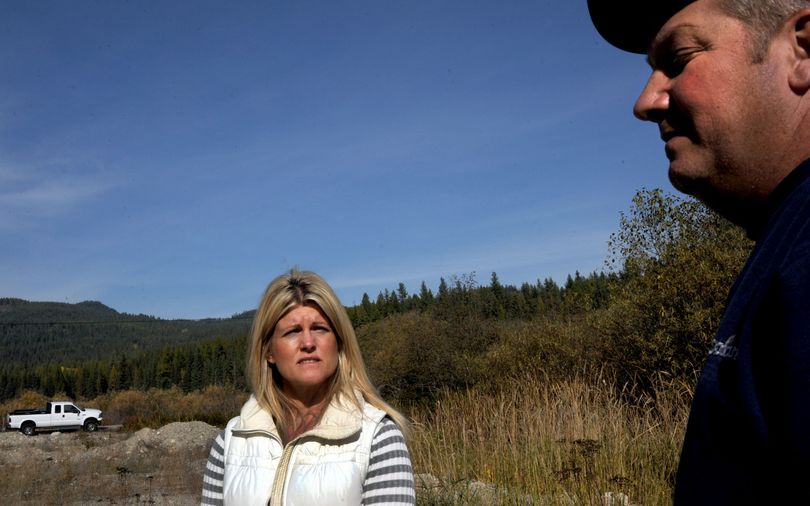High court hears Priest Lake EPA fight

Chantell and Mike Sackett talk about their battle with the Environmental Protection Agency over their right to build a home on a lot near Priest Lake on Oct. 19.(SRPhoto/Kathy Plonka) Read Becky Kramer's story here.
By Sean Cockerham,scockerham@mcclatchydc.com
WASHINGTON — The Supreme Court appeared sympathetic Monday to an Idaho couple’s fight to build their dream home over the objections of the Environmental Protection Agency, in a case that could have far broader implications and limit the EPA’s ability to regulate developers, energy companies and others.
Justice Samuel Alito said homeowners could relate to the situation of Idahoans Michael and Chantell Sackett.
“Don’t you think most ordinary homeowners would say this kind of thing can’t happen in the United States?” Alito asked the lawyer arguing for the government during oral arguments in the case Monday.
Alito called the EPA’s conduct “outrageous.” Justice Antonin Scalia spoke of the agency’s “high-handedness.”
The broad issue is whether landowners hit by EPA compliance orders should be allowed to immediately sue to overturn those orders, rather than waiting for the EPA to go to court to force compliance.
The case could have far-reaching implications, with environmental groups saying a Sackett victory could allow big corporate polluters to tie up the EPA in court instead of dealing with the problem.
The Sackett case has become a conservative rallying cry, with anti-EPA talk from radio hosts, lawmakers and business groups touting it as an example of an agency run amok. Idaho Republican Sen. Mike Crapo said, “This is what happens when an overzealous federal agency would rather force compliance than give any consideration to private property rights, individual rights, basic decency or common sense.”
The legal storm began after the Sacketts filled in dirt and rock on their property for a home they were building on about a half-acre near scenic Priest Lake in North Idaho.
Officials from the EPA appeared and asked the Sacketts whether they had a permit to fill in wetlands under the Clean Water Act. The EPA subsequently told the Sacketts to “remove all unauthorized fill material” and plant trees and bushes, saying the couple faced potential fines of up to $37,500 a day if they didn’t fully comply with the directive.
The Sacketts dispute the assertion that the land, which is in a subdivision, is really wetlands, and they challenged the EPA’s authority. The conservative Pacific Legal Foundation, which signed on to represent the Sacketts for free, argues landowners should get to challenge EPA compliance orders in court because otherwise they’re just at the mercy of the threat of big fines.
GE, the American Petroleum Institute, the National Association of Home Builders and 10 states filed court briefs in support of the Sacketts, underscoring the potential broad implications of the Idaho couple’s case.
The EPA says directives such as the one the Sacketts received are essentially just warnings with the goal of negotiating a solution. The government says a court challenge shouldn’t be allowed until the EPA actually goes to a judge in an attempt to seek enforcement of the order.
“It is phrased as an order. But the only thing that EPA is authorized to do ... is to order people to do what they were already legally required to do. That is, order them to comply with their legal obligations,” Justice Department attorney Malcolm Stewart argued Monday.
A Boise-based trial judge, appointed by President George H.W. Bush, and the 9th U.S. Circuit Court of Appeals sided with the EPA’s position in the case. So have the nation’s other four appellate circuits in similar cases.
It’s unusual for the Supreme Court to take up an issue when there has been such unanimous agreement among all the lower courts, leading to speculation that the high court’s conservative majority decided to hear the Idaho couple’s case because it is intent on striking a blow to the powers of the EPA.
The Supreme Court’s ruling in the case might not come until June, but it was clear at Monday’s hearing that justices were skeptical of the EPA’s position. Justice Stephen Breyer said he read the order and that it didn’t seem to him like a warning, but a government demand.
The EPA says the Sacketts should have sought a permit and that the couple did not consult with the agency or the Army Corps of Engineers before filling the land.
The Sacketts say they had no reason to suspect their land would be considered wetlands. An environmental group produced documents under the Freedom of Information Act, though, showing the couple disregarded the opinion of a wetlands expert.
Michael Sackett said Monday after the arguments that the man took just a cursory look at the property, spending less than half an hour and never shoveling down into the ground.
Sackett, who called it a “David versus Goliath” case, said he can’t see how his property, 500 feet from Priest Lake in an existing subdivision with a sewer hookup, can be considered wetlands that demand protection.